Statistical Characteristics of Blocking High in the Ural Mountains during Winters and Relationship with Changes in Sea Surface Temperature and Sea Ice
Abstract
1. Introduction
2. Materials and Methods
2.1. Materials
2.2. Methods
2.2.1. Tibaldi and Molteni (TM) Method
- (1)
- GHGS > 0
- (2)
- GHGN < −10 m/latitude distances
2.2.2. Morlet Wavelet Analysis Method
2.2.3. Synthetic Analysis
3. Results
3.1. Statistical Characteristics of Blocking Highs in Ural Mountains in Extended Winter
3.1.1. Change Characteristics of Frequency
3.1.2. Changing Characteristics of Days
3.1.3. Wavelet Analysis of Multiple Time Scales
3.2. Circulation Characteristics of Blocking Highs in Ural Mountains in Extended Winter
Synthesis Analysis
3.3. The Effects of SST and SI on Blocking Highs in the Extended Wintertime Ural Mountains
4. Discussion
5. Conclusions
- (1)
- During the 42 extended winters from 1979 to 2020, a total of 43 blocking high events occurred in the Ural Mountains. The annual average number of blocking high events was 1.02, and the frequency of occurrence followed a downward trend. In addition, these blocking high events covered 312 days in total, with an annual average blocking period of 7.43 days. Interestingly, most of the short-lived blocking high events occurred after the 1990s. In addition, the frequency of occurrence and accumulated days of blocking highs in extended winter generally followed a 3–4 years oscillating cycle.
- (2)
- As a while, the 500 hPa anomaly field constituted a “positive-negative-positive” cross-distribution situation. As a blocking high developed, the intensity of the positive anomaly center in the Ural Mountains initially increased and then weakened, while the negative anomaly center on the east side showed the opposite pattern. On the SAT anomaly field, the central strength of the positive anomalies near the Barents Sea first increased and then decreased during the blocking process; however, the central strength and meridional span of the negative anomalies in the Eurasian mid-latitudes continued to increase until the edge reached the eastern part of China.
- (3)
- The abnormally high SST in the North Atlantic sea area and the abnormal reduction of SI in the Barents-Kara Sea and the Chukchi Sea in autumn had a significant impact on the formation of Ural Mountain blocking highs in extended winter. By comparison, the abnormally low SST in the Eastern Equatorial Pacific Ocean in winter also demonstrated a certain effect on Ural Mountains blocking highs, though the effect was not significant. In addition, the reduction of SI in the Barents-Kara Sea and the Chukchi Sea in autumn might also have led to a westward positioning of Ural Mountains blocking highs.
Author Contributions
Funding
Institutional Review Board Statement
Informed Consent Statement
Data Availability Statement
Acknowledgments
Conflicts of Interest
References
- Li, Y.; Jin, R.H.; Wang, S.G. Statistical characteristics of blocking high in key regions affecting weather in China during 1950–2008. J. Lanzhou Univ. Nat. Sci. 2010, 46, 47–55. [Google Scholar]
- Masato, G.; Hoskins, B.J.; Woollings, T. Winter and summer Northern Hemisphere blocking in CMIP5 models. J. Clim. 2013, 26, 7044–7059. [Google Scholar] [CrossRef]
- Wu, J.; Diao, Y.; Zhuang, X.Z. The relationship between the Ural blocking in boreal winter and the East Asian winter monsoon. Clim. Environ. Res. 2016, 21, 577–585. [Google Scholar]
- Yang, G.; Kong, Q.; Mao, D.; Zhang, F.; Kang, Z.M.; Zong, Z.P. Analysis of the long lasting cryogenic freezing rain and snow weather in the beginning of 2008. Acta Meteorol. Sin. 2008, 66, 836–849. [Google Scholar]
- Shi, C.; Cai, W.; Jin, X. Modulation by transient waves of atmospheric longwave anomalies: Dynamic mechanism of the super cold wave in South China in the extremely strong El Nino of 2015/2016. Trans. Atmos. Sci. 2016, 39, 827–834. [Google Scholar]
- Li, Y.; Zhang, J.Y.; Lu, Y.; Zhu, J.; Feng, J. Characteristics of transient eddy fluxes during blocking highs associated with two cold events in China. Atmosphere 2019, 10, 235. [Google Scholar] [CrossRef]
- Davini, P.; Cagnazzo, C.; Anstey, J. A Blocking View of the Stratosphere-Troposphere Coupling; EGU General Assembly: Vienna, Austria, 2015. [Google Scholar]
- Oliveira, F.N.M.; Carvalho, L.M.V.; Ambrizzi, T. A new climatology for Southern Hemisphere blockings in the winter and the combined effect of ENSO and SAM phases. Int. J. Climatol. 2013, 34, 1676–1692. [Google Scholar] [CrossRef]
- Cheung, H.N.; Zhou, W.; Mok, H.Y.; Wu, M.C. Relationship between Ural-Siberian blocking and the East Asian winter monsoon in relation to the arctic oscillation and the El Nino-Southern oscillation. J. Clim. 2012, 25, 4242–4257. [Google Scholar] [CrossRef]
- Luo, D.; Xiao, Y.; Diao, Y.; Dai, A.; Franzke, C.L.; Simmonds, I. Impact of Ural blocking on winter warm arctic-cold Eurasian anomalies. Part II: The link to the North Atlantic Oscillation. J. Clim. 2016, 29, 3949–3971. [Google Scholar] [CrossRef]
- Cheung, H.N.; Zhou, W.; Shao, Y.; Chen, W.; Mok, H.Y.; Wu, M.C. Observational climatology and characteristics of wintertime atmospheric blocking over Ural-Siberia. Clim. Dyn. 2013, 41, 63–79. [Google Scholar]
- Tian, P.Y. Two Types of boreal wintertime blocking highs around Ural Mountains and their associated dynamic features. Master’s Thesis, Nanjing University of Information Science & Technology, Jiangsu, China, June 2019. [Google Scholar]
- Ma, X.Y.; Mu, M.; Dai, G.K.; Han, Z.; Li, C.; Jiang, Z. Influence of Arctic Sea Ice Concentration on Extended-Range Prediction of Strong and Long-Lasting Ural Blocking Events in Winter. J. Geophys. Res. Atmos. 2022, 5, e2021JD036282. [Google Scholar] [CrossRef]
- Lu, Y.; Li, X.; Li, Y.; Chen, Y. The Characteristics of Thermal and Momentum Transport During the Different Lifetimes of Ural Blocking Highs in Winter. Plateau Meteorol. 2022, 41, 671–683. [Google Scholar]
- Wang, S.Y.; Na, L.; Wang, P.; Zhu, X.W.; Li, X.; Ma, Y.; Zhang, W. Synergistic effects of ice and sea surface temperature on the precipitation abnormal in June in the central part of northwest China. Arid Land Geogr. 2021, 44, 63–72. [Google Scholar]
- Wiedenmann, J.M.; Lupo, A.R.; Mokhov, I.I.; Tikhonova, E.A. The climatology of blocking anticyclones for the Northern and Southern Hemispheres: Block Intensity as a Diagnostic. J. Clim. 2002, 15, 3459–3473. [Google Scholar] [CrossRef]
- Li, S.L. Impact of Northwest Atlantic SST Anomalies on the circulation over the Ural Mountains during early winter. J. Meteorol. Soc. Jpn. 2004, 82, 917–988. [Google Scholar] [CrossRef]
- Li, Y.; Lu, Y.; Wang, J.H.; Wang, Q. Effects of two types of ENSO events on the blockings in the Eurasian Region in winter. J. Lanzhou Univ. Nat. Sci. 2017, 53, 628–635. [Google Scholar]
- Overland, J.E.; Klaus, D.; Francis, J.A.; Hall, R.J.; Hanna, E.; Kim, S.-J.; Screen, J.A.; Shepherd, T.G.; Vihma, T. Nonlinear response of mid- latitude weather to the changing Arctic. Nat. Clim. Change 2016, 6, 992–999. [Google Scholar] [CrossRef]
- Feng, J.; Zhang, Y.; Tsou, J.; Wong, K. Analyzing variations in the association of Eurasian winter–spring snow water equivalent and autumn Arctic sea ice. Remote Sens. 2022, 14, 243. [Google Scholar] [CrossRef]
- Zhu, J.T.; Lu, Y.; Li, Y. Study on interdecadal variations of cold wave and genesis of atmospheric circulation in the Chinese Mainland from 1970 to 2019. J. Lanzhou Univ. (Nat. Sci.) 2022, 58, 337–355. [Google Scholar]
- Yao, Y.; Luo, D.H.; Dai, A.G.; Simmonds, I. Increased quasi stationary and persistence of winter Ural blocking and Eurasian extreme cold events in response to Arctic warming. Part I: Insights from observational analyses. J. Clim. 2017, 30, 3549–3568. [Google Scholar] [CrossRef]
- Woodruff, S.D.; Lubker, S.J.; Wolter, K.; Worley, S.J.; Elms, J.D. Comprehensive Ocean-Atmosphere Data Set (COADS) Release la: 1980-92. Earth Syst. Monit. 1993, 4, 1–8. [Google Scholar]
- Rayner, N.A. Global analyses of sea surface temperature, sea ice, and night marine air temperature since the late nineteenth century. J. Geophys. Res. Atmos. 2003, 108, 4407. [Google Scholar] [CrossRef]
- Shi, N.; Wang, Y. Energetics of Boreal Wintertime Blocking Highs around the Ural Mountains. J. Meteorol. Res. 2022, 36, 154–174. [Google Scholar] [CrossRef]
- Zhou, N. The spatial characters of blocking over Eurasia and its impact on temperature of China. J. Chengdu Univ. Inf. Technol. 2016, 31, 419–424. [Google Scholar]
- Lejenäs, H.; Økland, H. Characteristics of Northern Hemisphere blocking as determined from a long timeseries of observational data. Tellus 1983, 35, 350–362. [Google Scholar] [CrossRef]
- Tibaldi, S.; Molteni, F. On the operational predictability of blocking. Tellus 1990, 42, 343–365. [Google Scholar] [CrossRef]
- Morlet, J.; Arens, G.; Fourgeau, E.; Giard, D. Wave propagation and sampling theory—Part II: Sampling theory and complex waves. Geophysics 1982, 47, 222–236. [Google Scholar] [CrossRef]
- Le, T.P. Use of the Morlet mother wavelet in the frequency-scale domain decomposition technique for the modal identification of ambient vibration responses. Mech. Syst. Signal Process. 2017, 95, 488–505. [Google Scholar] [CrossRef]
- Chong, K.L.; Huang, Y.F.; Koo, C.H.; Ahmed, A.N.; El-Shafie, A. Spatiotemporal variability analysis of standardized precipitation indexed droughts using wavelet transform. J. Hydrol. 2021, 605, 2–19. [Google Scholar] [CrossRef]
- Zhang, S.W.; Lei, Y.J.; Feng, Y.Q. Application of Matlab in Time Series Analysis; Xidian University Press: Xi’an, China, 2007. [Google Scholar]
- Shi, X.J.; Zhi, X.F. Statistical characteristics of blockings in Eurasia from 1950 to 2004. Trans. Atmos. Sci. 2007, 30, 338–344. [Google Scholar]
- Ye, P.L.; Li, Y.; Wang, S.G.; Wang, X.J.; Shang, K.Z. Variation characteristics of different atmospheric blockings and their impact on temperature over the Northern Hemisphere. J. Lanzhou Univ. (Nat. Sci.) 2015, 51, 639–651. [Google Scholar]
- Zhou, X.P. Statistical investigation on the blocking situations over Asia. Acta Meteorol. Sin. 1957, 1, 77–87. [Google Scholar]
- Lu, Y. Study on the change characteristics and mechanism of Ural Blocking Highs under the global warming. Doctor’s Thesis, Lanzhou University, Lanzhou, China, June 2022. [Google Scholar]
- Wallace, J.M.; Gutzler, D.S. Teleconnections in the Geopotential Height Field during the Northern Hemisphere Winter. Mon. Weather Rev. 1981, 109, 784–812. [Google Scholar] [CrossRef]
- Han, Z.; Li, S.; Mu, M. The Role of Warm North Atlantic SST in the Formation of Positive Height Anomalies over the Ural Mountains during January 2008. Adv. Atmos. Sci. 2011, 28, 246–256. [Google Scholar] [CrossRef]
- Luo, B.; Luo, D.; Dai, A.; Simmonds, I.; Wu, L. Decadal variability of winter warm Arctic-cold Eurasia dipole patterns modulated by Pacific Decadal Oscillation and Atlantic Multidecadal Oscillation. Earth’s Future 2022, 10, e2021EF002351. [Google Scholar] [CrossRef]
- Luo, B.; Luo, D.; Dai, A.; Simmonds, I.; Wu, L. The modulation of Interdecadal Pacific Oscillation and Atlantic Multidecadal Oscillation on winter Eurasian cold anomaly via the Ural blocking change. Clim. Dyn. 2022, 59, 127–150. [Google Scholar] [CrossRef]
- Luo, B.; Wu, L.; Luo, D.; Dai, A.; Simmonds, I. The winter midlatitude-Arctic interaction: Effects of North Atlantic SST and high-latitude blocking on Arctic sea ice and Eurasian cooling. Clim. Dyn. 2019, 52, 2981–3004. [Google Scholar] [CrossRef]
- Shabbar, A.; Huang, J.; Higuchi, K. The relationship between the wintertime north Atlantic oscillation and blocking episodes in the north Atlantic. Int. J. Climatol. 2001, 21, 355–369. [Google Scholar] [CrossRef]
- Wan, H.; Luo, D.H. The relationship between wintertime blockings in the North Hemisphere and North Atlantic Oscillation. J. Trop. Meteorol. 2009, 25, 615–620. [Google Scholar]
- Chen, X.; Luo, D.; Wu, Y.; Dunn-Sigouin, E.; Lu, J. Nonlinear response of atmospheric blocking to early winter Barents–Kara Seas warming: An idealized model study. J. Clim. 2021, 34, 2367–2383. [Google Scholar] [CrossRef]
- Chen, X.; Luo, D.; Feldstein, S.B.; Lee, S. Impact of winter Ural blocking on Arctic sea ice: Short-time variability. J. Clim. 2018, 31, 2267–2282. [Google Scholar] [CrossRef]
- Gong, T.; Luo, D. Ural blocking as an amplifier of the Arctic sea ice decline in winter. J. Clim. 2017, 30, 2639–2654. [Google Scholar] [CrossRef]
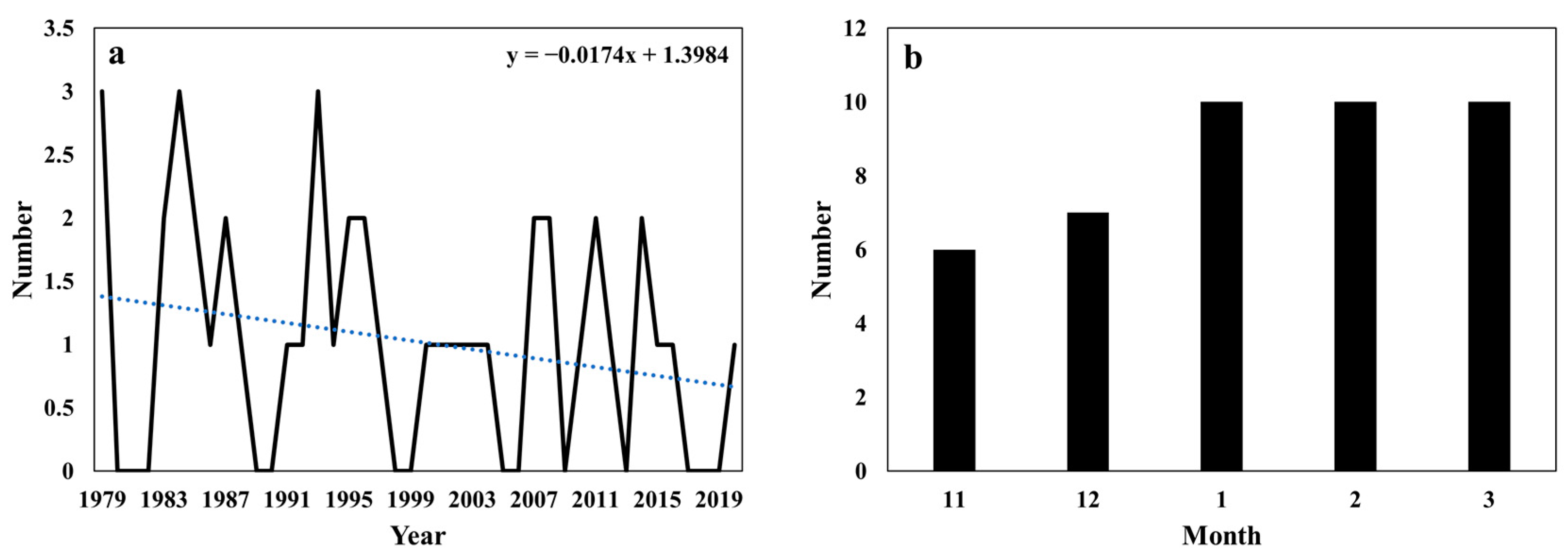
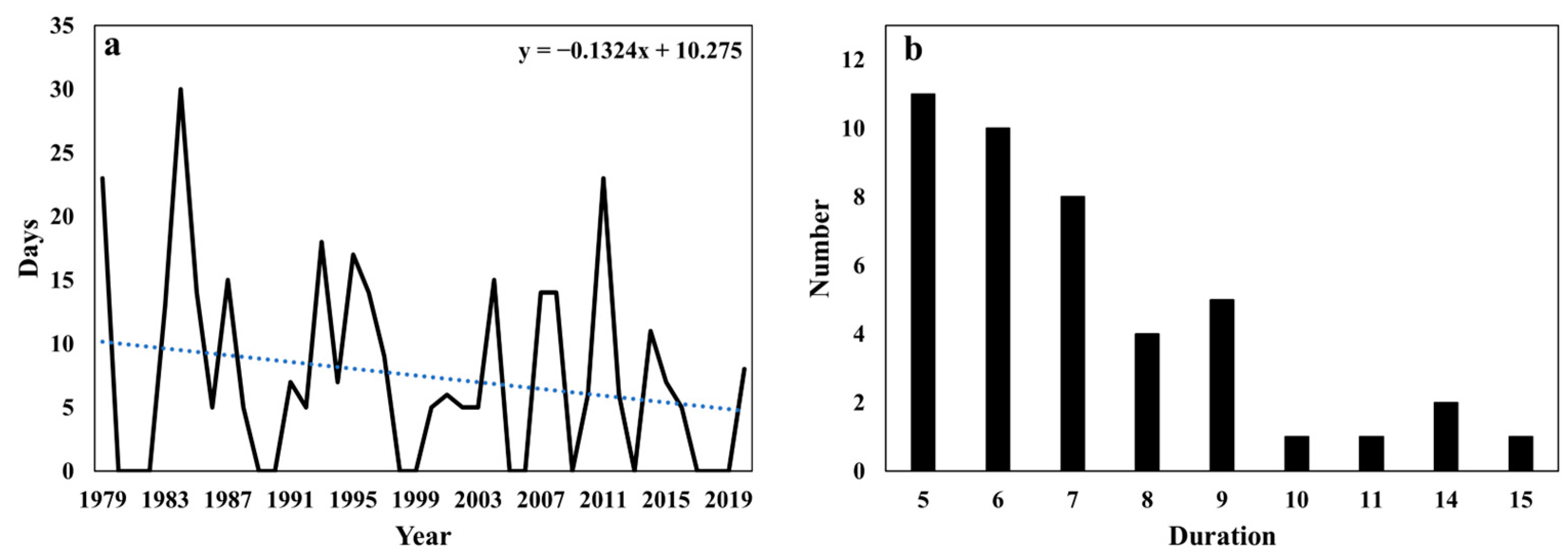

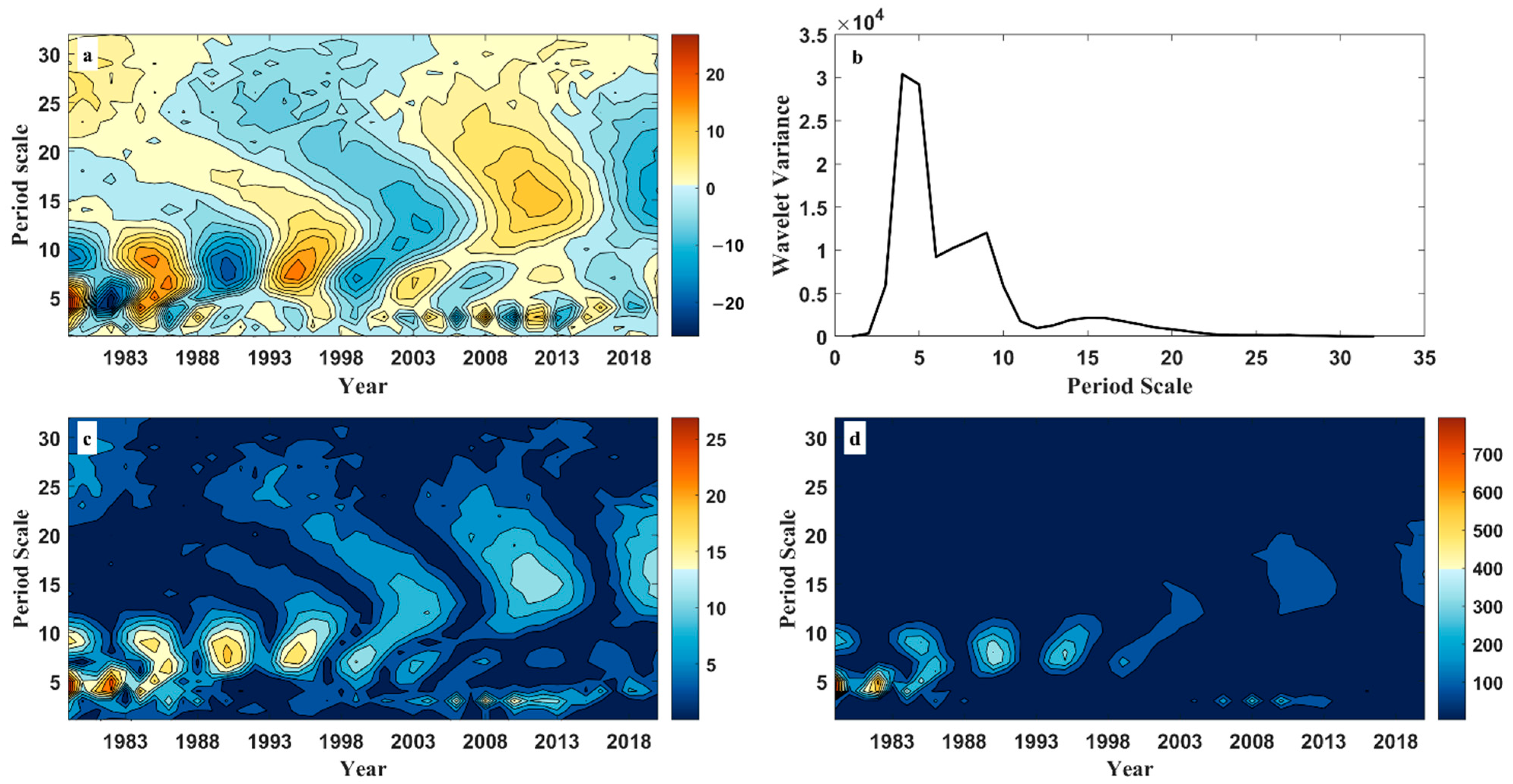
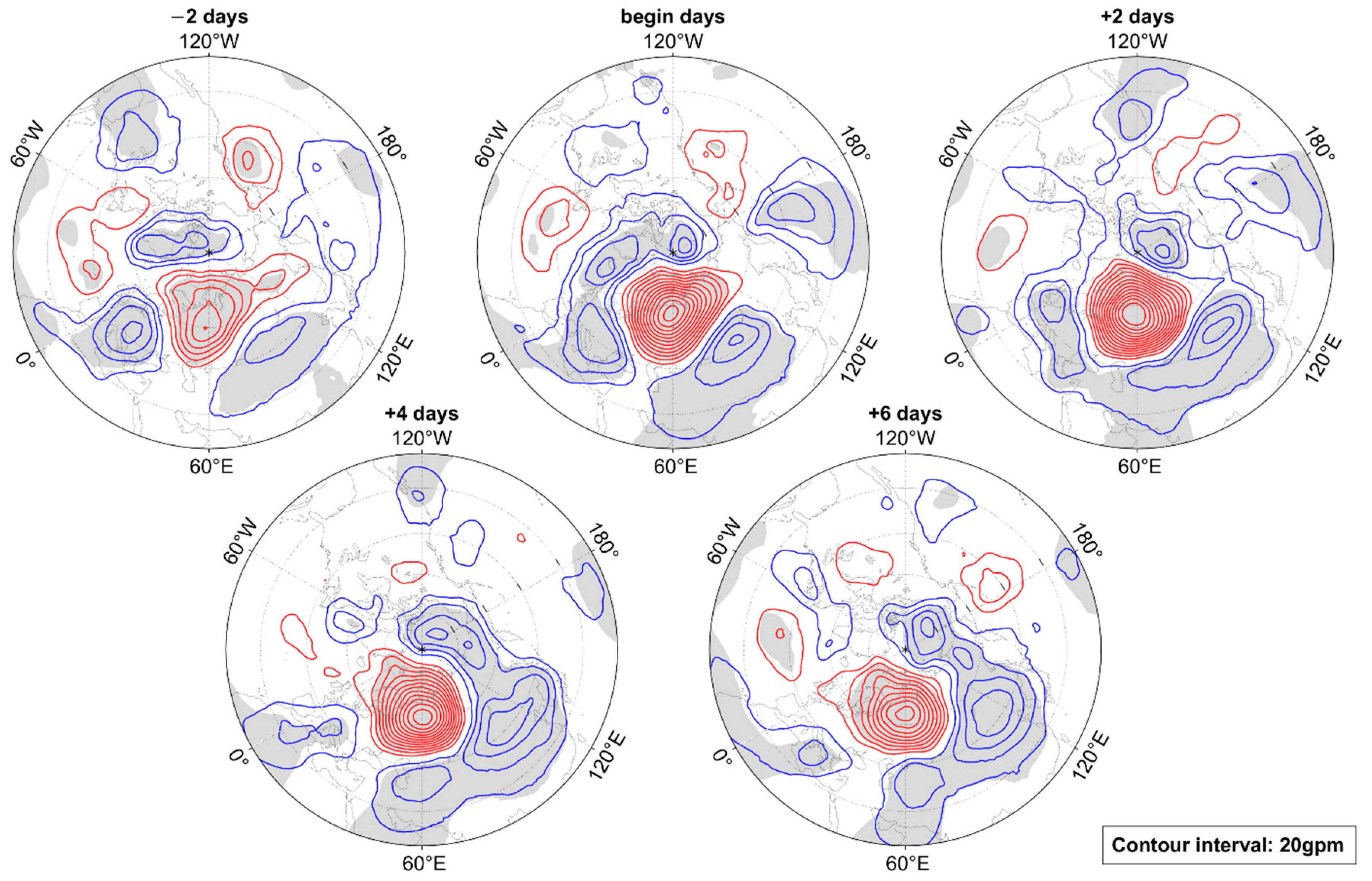
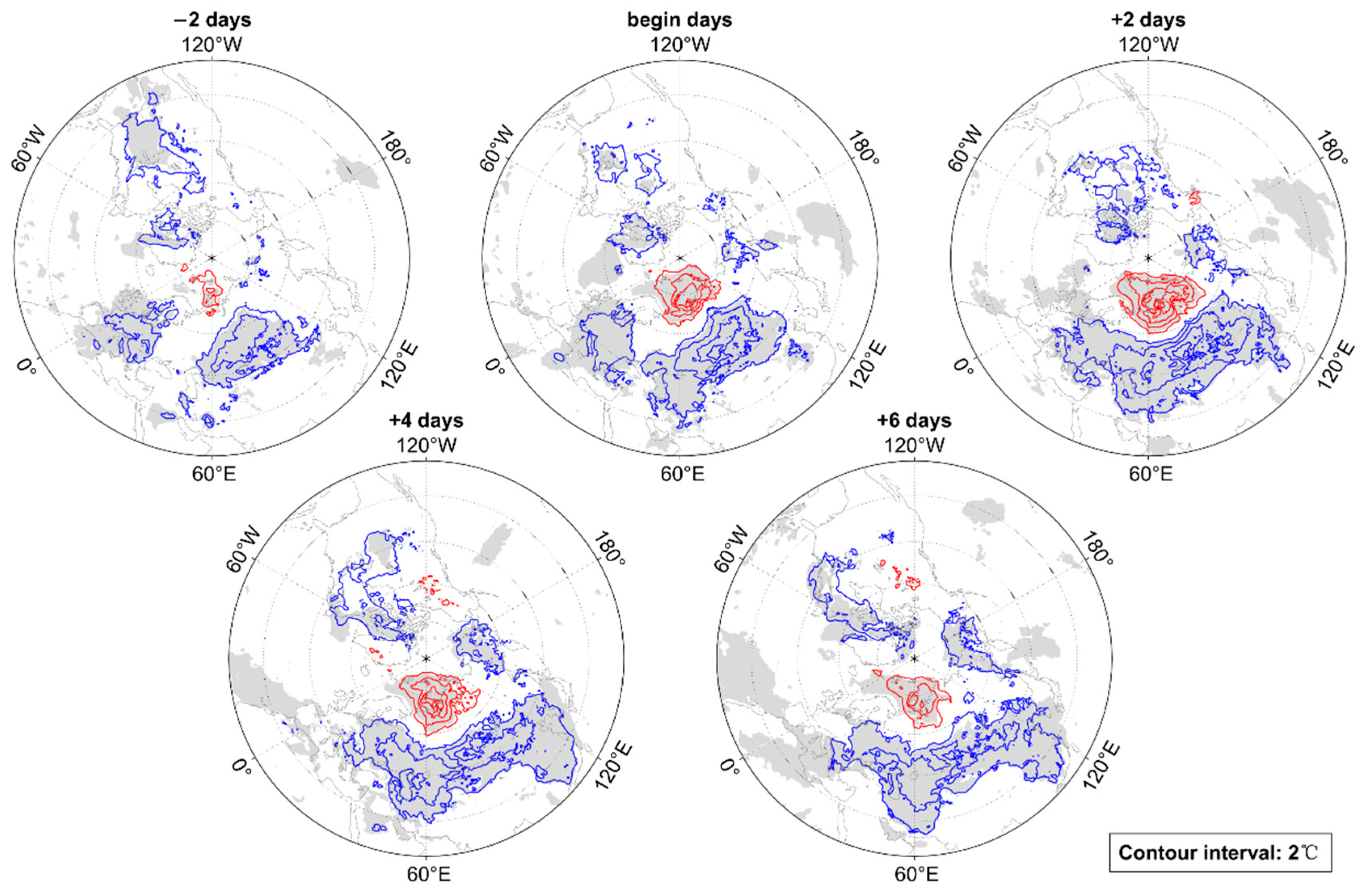

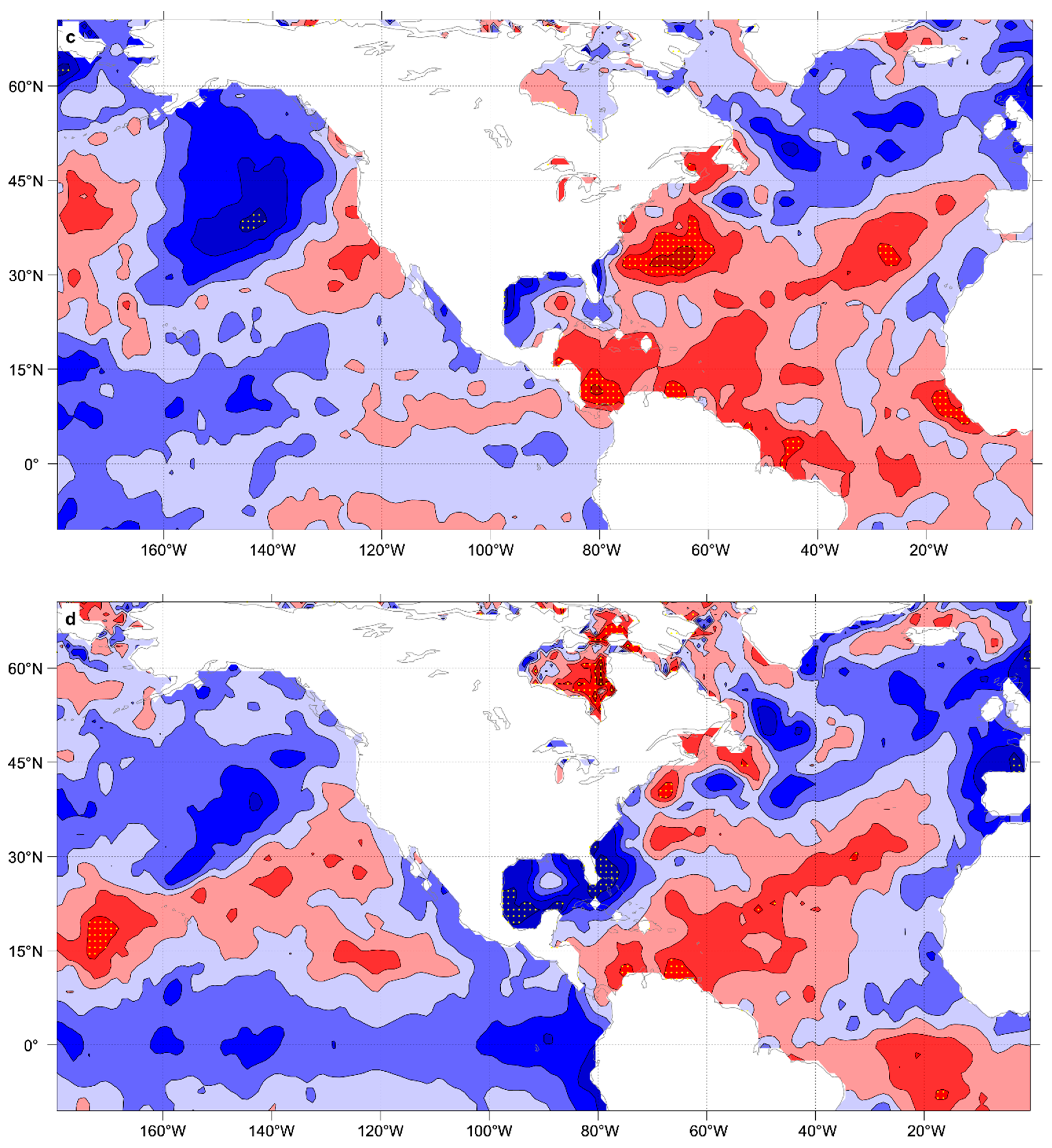
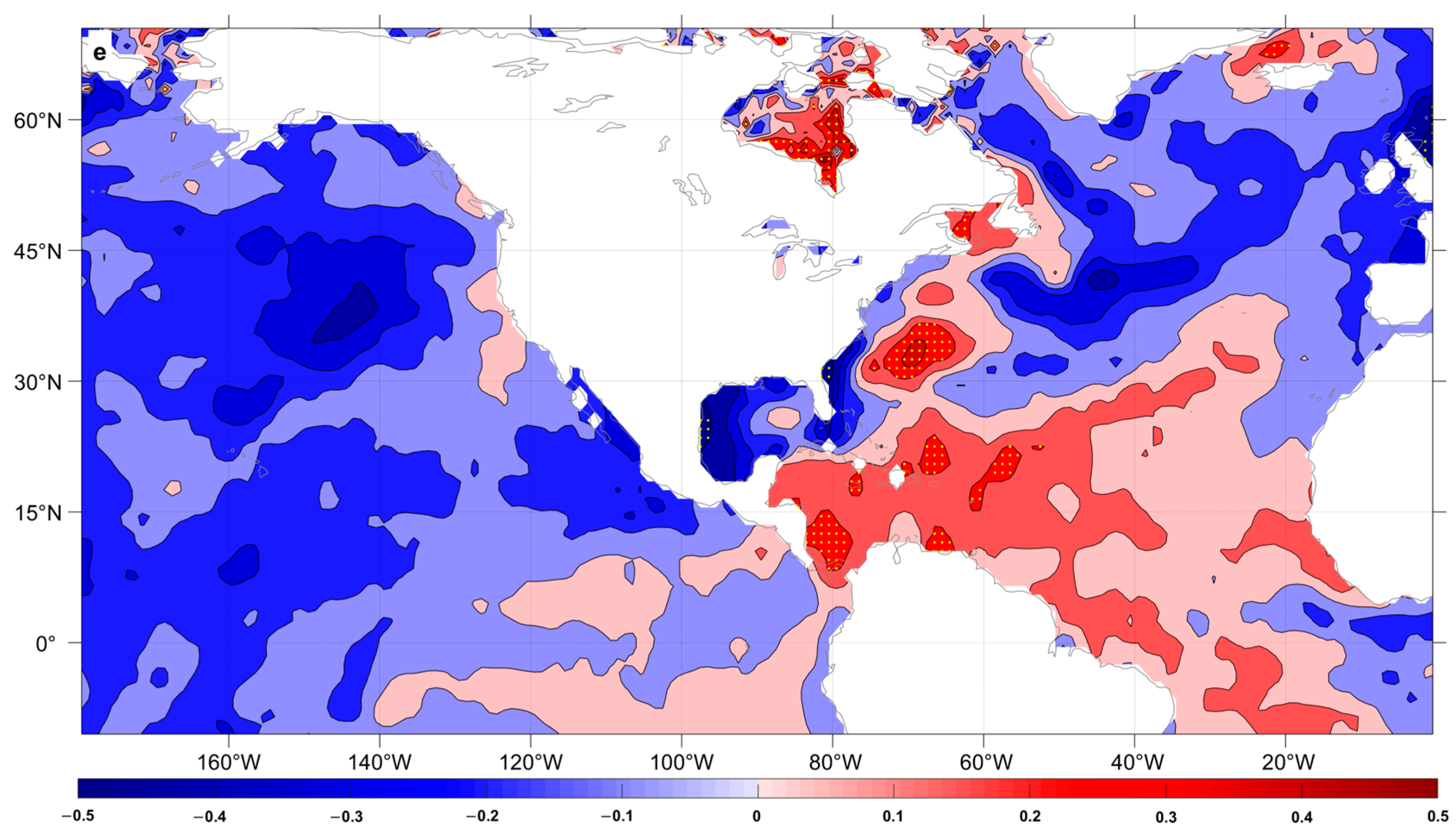



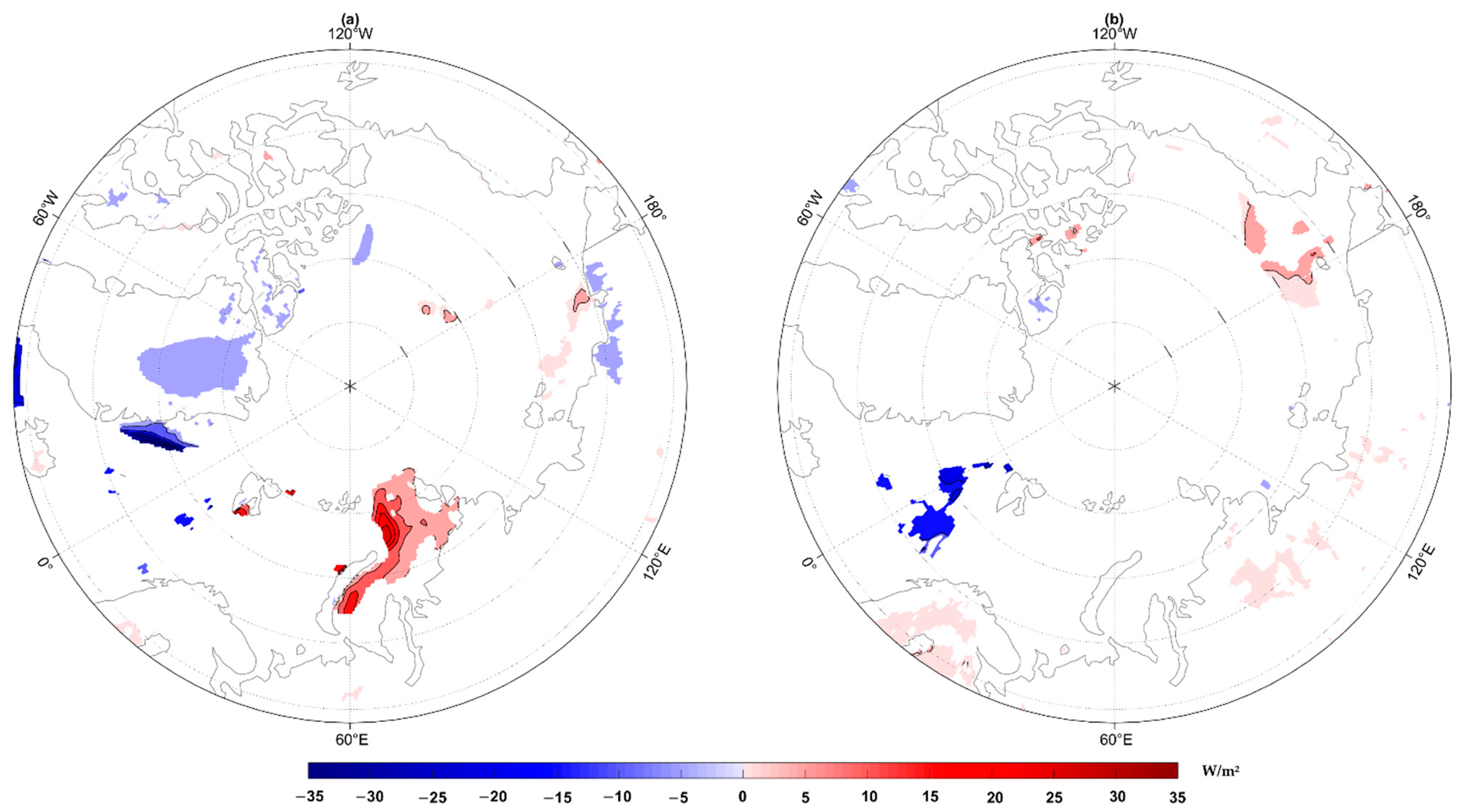
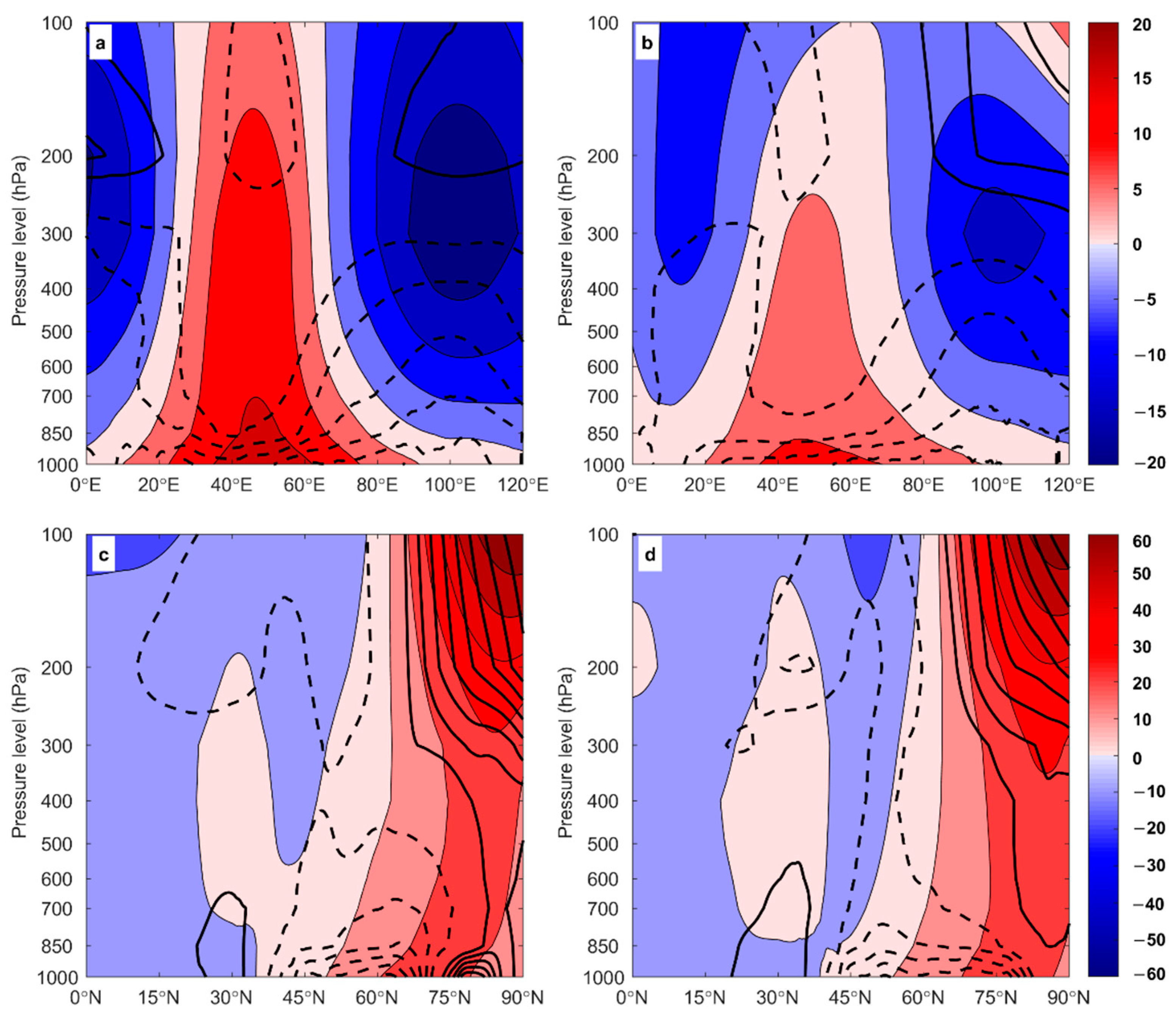
Disclaimer/Publisher’s Note: The statements, opinions and data contained in all publications are solely those of the individual author(s) and contributor(s) and not of MDPI and/or the editor(s). MDPI and/or the editor(s) disclaim responsibility for any injury to people or property resulting from any ideas, methods, instructions or products referred to in the content. |
© 2023 by the authors. Licensee MDPI, Basel, Switzerland. This article is an open access article distributed under the terms and conditions of the Creative Commons Attribution (CC BY) license (https://creativecommons.org/licenses/by/4.0/).
Share and Cite
Liu, Y.; Zhang, Y. Statistical Characteristics of Blocking High in the Ural Mountains during Winters and Relationship with Changes in Sea Surface Temperature and Sea Ice. Atmosphere 2023, 14, 129. https://doi.org/10.3390/atmos14010129
Liu Y, Zhang Y. Statistical Characteristics of Blocking High in the Ural Mountains during Winters and Relationship with Changes in Sea Surface Temperature and Sea Ice. Atmosphere. 2023; 14(1):129. https://doi.org/10.3390/atmos14010129
Chicago/Turabian StyleLiu, Yingying, and Yuanzhi Zhang. 2023. "Statistical Characteristics of Blocking High in the Ural Mountains during Winters and Relationship with Changes in Sea Surface Temperature and Sea Ice" Atmosphere 14, no. 1: 129. https://doi.org/10.3390/atmos14010129
APA StyleLiu, Y., & Zhang, Y. (2023). Statistical Characteristics of Blocking High in the Ural Mountains during Winters and Relationship with Changes in Sea Surface Temperature and Sea Ice. Atmosphere, 14(1), 129. https://doi.org/10.3390/atmos14010129




